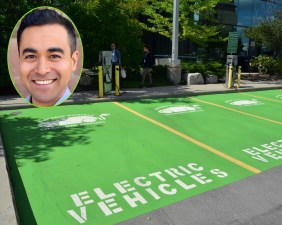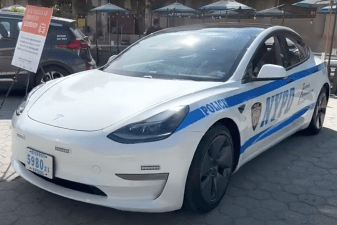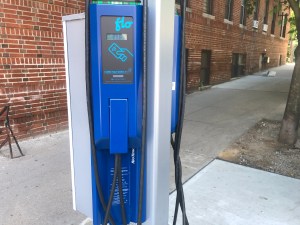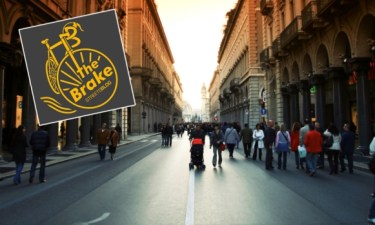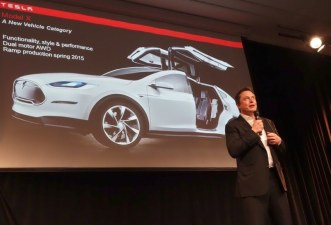Op-Ed, Part II: Conversion to EVs is a Once-in-a-Century Chance to Fix Many Car Culture Problems


This is the second part of a two-part examination of the coming onslaught of electric cars. Part I argued that public space in the city’s limited curbside lanes should not be set aside for electric charging because that will only cement the city’s longstanding car problems. Part II is below.
In New York City, $75 million in funding announced last year will go towards three key areas: acquiring new electric vehicles to replace fossil fuel-powered ones, retrofitting existing fossil fuel-powered vehicles with electric drivetrains, and installing new electric vehicle charging infrastructure. The New York Police Department is on track to receive 250 Teslas and 180+ e-Mustangs; on the charging front, 275 fast vehicle chargers — including street-side chargers — will come online within the next two years.
When managing technological change, it is common practice — and a good opportunity — to avoid one-for-one replacement and instead, take in account new needs, new processes, and unintended consequences. The MTA is building a depot for electric buses, and the Port Authority is planning a new bus terminal ready for electrical vehicles. In contrast, NYPD seems poised to engage in one-for-one replacement of all of its vehicles, in which case the current illegal parking chaos surrounding NYPD precincts will be compounded and made permanent by the installation of sidewalk chargers.
The city must retool for the future, not the past.
Before converting its fleets, the city should assess their current use: do Department of Environmental Protection and Department of Transportation personnel need cars? Do traffic agents need their own transportation or could they use the subway? What are police cars and vans used for? How many times a month are they used to efficiently transport multiple passengers? Our casual observations show that such occurrences are extremely rare.
Flashback to Part I: Do Not Put EV Charging Stations on Public Property
NYPD’s Neighborhood Coordination Officers would be perfect initial candidates to use electric bikes and mopeds instead of police cars. In the traffic department, highway enforcement officers rely on large motorcycles; why not most cops in the city?
This re-evaluation would deliver an NYPD that would be more agile in New York City traffic, but it would also point to the deficiencies in infrastructure. Many precincts are housed in buildings that date from the beginning of the last century. A prime example is the 52nd Precinct station house (and stable!) in the Norwood section of the Bronx, which was built in 1904-1906 and remains a cesspool of illegal parking. A proper garage and electrical charging station for official NYPD vehicles is a must in each precinct.
Similarly, Fire Department and hospital ambulances as a whole should be re-evaluated. The Department of Sanitation should be focusing on adding smaller electric vehicles to service bike lanes and pedestrian infrastructure as well as new features to allow their trucks to pick up containers.
And no charging capacity should be deployed at curbside for official or private cars of municipal employees, including elected officials. If needed, those will be served by charging stations on private property in the future. (See Part I of this series.)
Leverage the city’s power
New York City could use incentives to require that all companies who work with the city — such as Con Edison and delivery operators — use electric vehicles exclusively. Additionally, companies that get exemptions to the idling laws, such as government vehicles, MTA buses, postal trucks, armored car companies and Spectrum, must be incentivized to shift to greener fleets.
Taxis and “Ubers” are also prime candidates, especially if the incentive is structured in a way that reduces the number of SUVs.
Next, create a mandate for developers to equip their construction sites with a charging station. Focusing on the construction industry would yield triple benefits: by making construction sites eligible for incentives to use only electric trucks, the city would eliminate emissions from diesel engines and truck idling, and accelerate the conversion of the construction industry to electric.
Electrifying cars is the right thing to do, but excessive number of cars, oversized vehicles, and use of the curb for private auto storage remain crucial deficiencies of the city government’s automotive infrastructure in New York. Downsizing the fleets and insuring they have proper storage and a private charging infrastructure is the most efficient way to improve the environment for people and not just for the cars.
Christine Berthet (@Chekpeds) co-founded CHEKPEDS (Clinton Hells Kitchen Coalition for Pedestrian Safety) in 2005. She is a longtime member of Manhattan Community Board 4 and is currently the board’s Transportation Committee co-chair.
